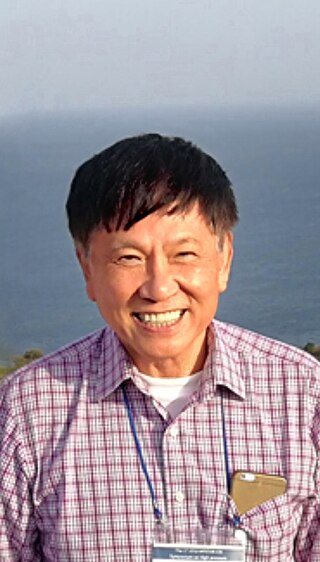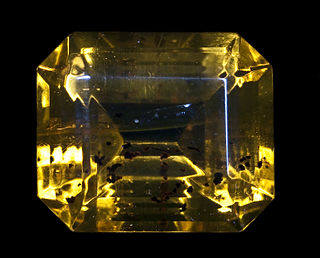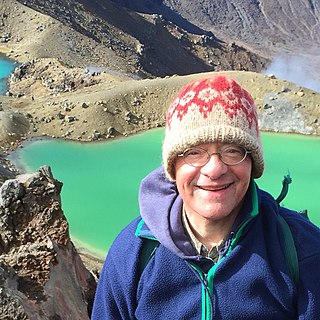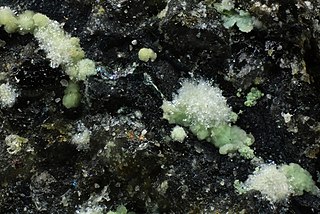Related Research Articles

Mineralogy is a subject of geology specializing in the scientific study of the chemistry, crystal structure, and physical properties of minerals and mineralized artifacts. Specific studies within mineralogy include the processes of mineral origin and formation, classification of minerals, their geographical distribution, as well as their utilization.

Mindat.org is a non-commercial interactive online database covering minerals around the world. Originally created by Jolyon Ralph as a private project in 1993, it was launched as a community-editable website in October 2000. As of 2023 it is operated by the Hudson Institute of Mineralogy.

Ho-Kwang (Dave) Mao is a Chinese-American geologist. He is the director of the Center for High Pressure Science and Technology Advanced Research in Shanghai, China. He was a staff scientist at Geophysical Laboratory of the Carnegie Institution for Science for more than 30 years. Mao is a recognized leading scientist in high pressure geosciences and physical science. There are two minerals named after him, Davemaoite and Maohokite.

Robert Miller Hazen is an American mineralogist and astrobiologist. He is a research scientist at the Carnegie Institution of Washington's Geophysical Laboratory and Clarence Robinson Professor of Earth Science at George Mason University, in the United States. Hazen is the Executive Director of the Deep Carbon Observatory.
The Deep Carbon Observatory (DCO) is a global research program designed to transform understanding of carbon's role in Earth. DCO is a community of scientists, including biologists, physicists, geoscientists and chemists, whose work crosses several traditional disciplinary lines to develop the new, integrative field of deep carbon science. To complement this research, the DCO's infrastructure includes public engagement and education, online and offline community support, innovative data management, and novel instrumentation development.

An organic mineral is an organic compound in mineral form. An organic compound is any compound containing carbon, aside from some simple ones discovered before 1828. There are three classes of organic mineral: hydrocarbons, salts of organic acids, and miscellaneous. Organic minerals are rare, and tend to have specialized settings such as fossilized cacti and bat guano. Mineralogists have used statistical models to predict that there are more undiscovered organic mineral species than known ones.

Rodney Charles Ewing was an American mineralogist and materials scientist whose research is focused on the properties of nuclear materials.
Peggy-Kay Hamilton (1922–1959) was born in Illinois in 1922 and was an American Research Associate in Mineralogy in the Department of Geology at Columbia University. One of Hamilton's first research breakthroughs was developing Research Project 49, otherwise known as the study of clay minerals. In her later research years, her focus shifted and led to her becoming involved full time in the study of uranium.

Mark S. Ghiorso is an American geochemist who resides in Seattle, Washington. He is best known for creating MELTS, a software tool for thermodynamic modeling of phase equilibria in magmatic systems.
Braunerite is a hydrous uranyl carbonate mineral discovered by Jakub Plášil of the Institute of Physics at the Academy of Sciences of the Czech Republic and colleagues in the Svornost mine in the Jáchymov ore district, Western Bohemia, Czech Republic.
Although diamonds on Earth are rare, extraterrestrial diamonds are very common. Diamonds small enough that they contain only about 2000 carbon atoms are abundant in meteorites and some of them formed in stars before the Solar System existed. High pressure experiments suggest large amounts of diamonds are formed from methane on the ice giant planets Uranus and Neptune, while some planets in other planetary systems may be almost pure diamond. Diamonds are also found in stars and may have been the first mineral ever to have formed.

Abellaite is a hydrous carbonate mineral discovered in the abandoned Eureka uranium mine in the village of Torre de Capdella (Lleida province), Catalonia, Spain. The ideal chemical formula of abellaite is NaPb2(CO3)2(OH). It is named in honor of Joan Abella i Creus, a Catalan gemmologist who has long studied minerals from the Eureka mine and first found abellaite in the mine. A team composed, among others, by Jordi Ibáñez-Insa from the Institute of Earth Sciences Jaume Almera (CSIC) and by Joan Viñals and Xavier Llovet from the University of Barcelona, identified and characterized the mineral’s structure and chemical composition.
Marklite is a hydrated copper carbonate mineral named after Gregor Markl, a German mineralogist at the University of Tübingen. Markl found the type specimen of marklite in the dumps of the Friedrich-Christian mine in the Black Forest Mountains in southwestern Germany. Markl specializes in crustal petrology and geochemistry and has studied the hydrothermal ore deposits of the Black Forest area. Jakub Plášil of the Institute of Physics at the Academy of Sciences of the Czech Republic and colleagues identified its structure.

Parisite-(La) is mineral discovered by Daniel Atencio of the University of São Paulo and colleagues in the Mula claim, Bahia, Brazil. Parisite-(La) is the lanthanum analog of parisite-(Ce), which has the same structure, but with cerium substituted for lanthanum. Parisite-(La) is chemically similar to synchysite-(La).

Joan Abella i Creus is a Catalan gemmologist and mineralogist who discovered abellaite, a mineral that receives this name in his honor
Ann Phyllis Sabina Stenson was a Canadian mineralogist, gemmologist, teacher, public servant and popular science author. Sabina has been instrumental in the development of X-ray diffraction as a means of identifying minerals. She is credited with the discovery of a variety of different minerals and currently has one named in her honor: Sabinaite. a string of educational books and guides that focus on the study of numerous minerals throughout Canada, and has been important in the creation of a number of geological associations.

Michael Fleischer was an American chemist and mineralogist. He worked as a geochemist with the U.S. Geological Survey from 1939 to 1978. He published a huge number of chemical abstracts and reviews of proposed mineral names, and is known for his authoritative Glossary of Mineral Species, first published in 1971.

Mineral evolution is a recent hypothesis that provides historical context to mineralogy. It postulates that mineralogy on planets and moons becomes increasingly complex as a result of changes in the physical, chemical and biological environment. In the Solar System, the number of mineral species has grown from about a dozen to over 5400 as a result of three processes: separation and concentration of elements; greater ranges of temperature and pressure coupled with the action of volatiles; and new chemical pathways provided by living organisms.
The carbonate chlorides are double salts containing both carbonate and chloride anions. Quite a few minerals are known. Several artificial compounds have been made. Some complexes have both carbonate and chloride ligands. They are part of the family of halocarbonates. In turn these halocarbonates are a part of mixed anion materials.

John Leslie Jambor was a Canadian geologist and mineralogist. Jambor was an exceptional figure in the field of mineralogy and a major contributor to the Mineralogical Association of Canada (MAC).
Jambor has a Scopus h-index of 38.
References
- ↑ "The carbon mineral challenge: A worldwide hunt for new carbon minerals". Phys.org. Retrieved 27 September 2016.
- ↑ Wilson, Elizabeth (22 December 2015). "Worldwide Hunt Begins for Missing Carbon Minerals". Scientific American. Retrieved 21 September 2016.
- 1 2 Deep Carbon Observatory: Announcing the Carbon Mineral Challenge
- ↑ AGU Fall Meeting: The Carbon Mineral Challenge: A worldwide hunt for new carbon minerals (Workshop)
- ↑ deepcarbon.net
- ↑ Ivy Shih (9 March 2016). "Discovery of carbon on Mercury reveals the planet's dark past". The Conversation. Retrieved 5 October 2016.
- ↑ Hazen, Robert M.; Jones, Adrian P.; Baross, John A. (eds.). "1" (PDF). Carbon in Earth. Reviews in Mineralogy & Geochemistry. ISBN 978-0-939950-90-4.
- 1 2 Hazen, Robert M.; Hummer, Daniel R.; Hystad, Grethe; Downs, Robert T.; Golden, Joshua J. (2016). "Carbon mineral ecology: Predicting the undiscovered minerals of carbon" (PDF). American Mineralogist. 101 (4): 889–906. Bibcode:2016AmMin.101..889H. doi:10.2138/am-2016-5546. S2CID 741788 . Retrieved 23 June 2017.
- ↑ "The Co-Evolution of the Geo- and Biospheres: An Integrated Program for Data-Driven, Abductive Discovery in the Earth Sciences". Carnegie Institution for Science. Retrieved 23 June 2017.
- ↑ "The Carbon Mineral Challenge | Carbon Mineral Challenge". mineralchallenge.net.
- ↑ Magazine, Smithsonian; Wei-Haas, Maya. "We Are Missing At Least 145 Carbon-Bearing Minerals, and You Can Help Find Them". Smithsonian Magazine.
- ↑ "Worldwide Hunt Begins for Missing Carbon Minerals". Scientific American . Archived from the original on 17 April 2023.
- 1 2 "New Carbon Minerals". Carbon Mineral Challenge. May 2019. Retrieved 23 January 2020.
- ↑ "Carbon Mineral Challenge". mineralchallenge.net.
- ↑ "Three new uranium minerals from Utah". Science Daily. Archived from the original on 9 February 2017. Retrieved 24 June 2017.
- ↑ Sid Perkins (4 October 2016). "Rock hounds are on the hunt for new carbon minerals". Science News. Retrieved 5 October 2016.